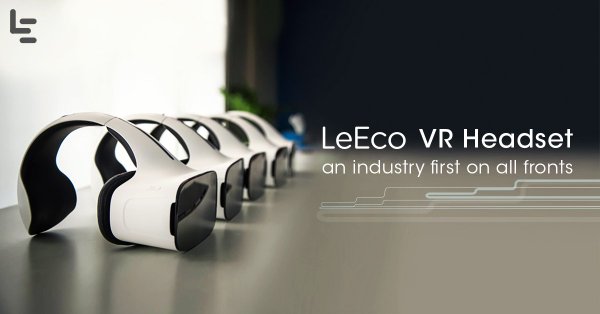LeEco Takes Aim At Samsung Gear VR With Its Own Mobile 'ExploreVR' HMD
Another company has thrown its hat into the VR ring, as LeEco joined the ranks of Huawei and ZTE as a Chinese multinational making a push for recognition and success in the U.S.
Starting as a video streaming service, LeEco has spread into TVs, phones, auto, and even bicycles. The company may be best known to U.S. audiences for purchasing U.S.-based TV manufacturer Vizio in July of this year. LeEco’s latest effort push includes new smart TVs, a line of smartphones, and of particular note, a new VR headset.
Mobile VR Showdown
Unlike higher-end, all-in-one devices like the Oculus Rift and HTC Vive, the new LeEco ExploreVR headset seems to be a direct shot at Samsung's Gear VR and other mobile headsets (including, perhaps, Google).
It actually resembles the Gear VR a little too closely. The LeEco ExploreVR is a phone-based system, connecting the phone to the headset using a USB-C connector, with gyroscope and accelerometer sensors built into the HMD. The ExploreVR only supports phones running LeEco VR, the company's proprietary VR app and marketplace. Although the list of supported devices isn’t confirmed, at launch it will be restricted to LeEco phones.
The new LeEco phones have done away with the headphone jack, but LeEco has made a big deal of its "continual Digital Lossless Audio" that promises ultra-high fidelity audio via the USB port. Unfortunately, that same USB port is used to connect to the ExploreVR VR HMD, meaning LeEco’s phones can’t use the VR headset and their own headphone system simultaneously.
LeEco reps stressed that the ExploreVR VR hardware isn’t finalized (among the list of other things not yet finalized: supported phones, Daydream support, content partners, launch timeline), but my initial impressions left something to be desired.
Smooth Lines, Rough Edges
First off, the headeset is heavy. Very heavy. It has a built-in support that wraps over the top of your head, and the heavy-duty reinforcement is necessary to keep the viewer from sliding off your face, but unfortunately it just adds to the weight.
Get Tom's Hardware's best news and in-depth reviews, straight to your inbox.
In its presentation, LeEco stressed the high quality of the lenses used, and indeed, the viewer had a wide field of view (FOV) with strong clarity. However, other aspects of the lenses were less than ideal. Both demos on display were fly-throughs of an animated town, and if you turned to look to either side, the warping became extremely apparent, as the passing scenery appeared to bulge and shift. This occurred even if you weren’t moving; any part of the animated scene moving across the lenses exhibited distinct warping and distortion.
The software itself seems to still have some issues, as well. In addition to the warping problem, whenever you move your head, the scene noticeably blurs and shifts. This is probably an artifact of the frame rate, which was low enough to show visible stuttering. The motion tracking was also suspect, and the scene wobbled and shifted a few times even when I kept my head perfectly still. I have used Gear VR and Vive for hours without issue, but the ExploreVR was the first headset that made me start to feel motion sickness, and I wore it for only 90 seconds.
The LeEco reps reiterated that the headset is early in development, and therefore in theory some of these problems should be solvable. The headset is based on the Snapdragon VR SDK, and the new LeEco phones pack the new Snapdragon 821 processor, which should be more than capable of delivering a smooth VR experience. (For reference, Qualcomm asserts that the Snapdragon 820 should be capable of rendering a 3200x1800 pixel scene at 90FPS). The 821 also supports Daydream, so it is possible we’ll see Daydream integration in the future.
New Controls In Hand
One interesting thing that was on display was a 6DOF tracking system from a company called Ximmerse, which will be a launch partner with LeEco VR. Similar to Playstation VR, the Ximmerse system is based on three colored lights--one on the headset and two on hand-held controllers--and a camera to provide room-scale tracking. The tracking looked responsive, and the addition of hand controllers is welcome.
Ximmerse's co-founder said the system is already Daydream ready and compatible with a range of mobile VR headsets.
LeEco should be able to iron out the kinks in its system, but without refining the VR experience itself and improving the construction, it will have a hard time competing with the Gear VR and even Google Daydream-based viewers.
-
vider About time we started acknowledging other brands, that have almost to none existent market penetration in the West.Reply
Xiomi, MEZIU, THL, Cubot, UMI and so many more.
Given not all of those brands have the same quality as Samsung, LG, HTC and the like, yet the bang for your buck is unbelievable.
Just take a look at the some of the specs within the latest UMI Super and you'll know what I mean.
hopefully we'll have more choice as more of thos manufactures break into the Western mobile market.
Good read btw!



